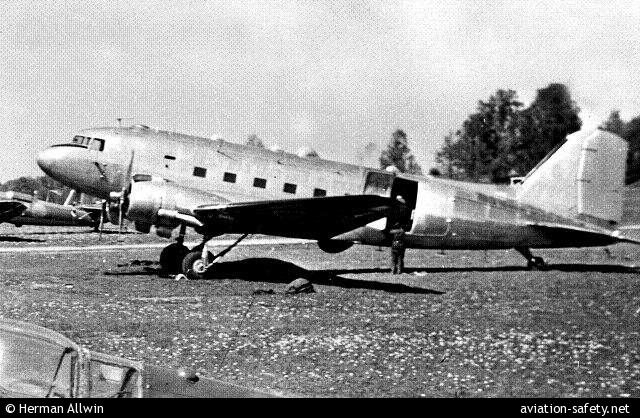
| Date: | Friday 13 June 1952 |
| Time: | 11:30 |
| Type: |  Douglas Tp 79 (C-47-DL) |
| Owner/operator: | Svensk Flygvapnet (Swedish Air Force) |
| Registration: | 79001 |
| MSN: | 9001 |
| Year of manufacture: | 1943 |
| Total airframe hrs: | 3454 hours |
| Engine model: | Pratt & Whitney R-1830-92 |
| Fatalities: | Fatalities: 8 / Occupants: 8 |
| Aircraft damage: | Destroyed, written off |
| Category: | UI |
| Location: | 56 km E off Gotska Sandön island [Baltic Sea] -
 Atlantic Ocean Atlantic Ocean
|
| Phase: | En route |
| Nature: | Military |
| Departure airport: | Stockholm-Bromma Airport (BMA/ESSB) |
| Stockholm-Bromma Airport (BMA/ESSB) | |
| Confidence Rating: |
The ELINT-plane was surveying Soviet military installations in what are now the Baltic states of Estonia, Latvia and Lithuania. It was shot down by a Soviet Mig-15bis fighter jet over the Baltic Sea. A search for the lost DC-3 began immediately both by sea and by air with two Consolidated Catalina planes.
On the 16 June, one of the Catalinas was attacked by two soviet MiG-15s over international water north-west of Dagö. They were pursued to the west under continued firing and was finally forced to land. The crew was picked up by a West German ship; 10 minutes later the Catalina sank. The Soviet Union denied involvement in the shootdown of the DC-3 until 1991. The wreckage was found on June 18, 2003 and later salvaged. It's on display at the Swedish Air Force Museum in Linköping.
According to a 2007 technical investigation, the cause of the crash was the failed emergency landing as a result of the damage received from the firing of the Soviet fighter aircraft of type MiG-15bis. The shooting took place with 23 and 37 mm grenades. At the time of the shooting, at least one explosive grenade struck in the area at the left engine oil tank, resulting in a heavy fire in the oil tank and possibly that fuel may have sprayed from fired fuel lines and fuel filling pipes. The hydraulic lines probably caused damage to the landing gear. Due to the fire, the pilot has probably intended to land at sea as soon as possible. It is possible that low clouds and fog banks have caused the pilot to make eye contact with the water surface at a late stage and therefore have not been able to start picking up and moving out. The landing has been made more difficult by the landing gear being folded out and possibly by the fact that the left engine may have been turned off with a non-flung propeller
Accident investigation:
 |
|
Sources:
Cold War Spy Plane Found in Baltic Sea (NGC)
Technical investigation report (2007)
Location
Images:

photo (c) Herman Allwin; F 8 Barkarby; 1951
Revision history:
| Date/time | Contributor | Updates |
|---|
The Aviation Safety Network is an exclusive service provided by:


 ©2024 Flight Safety Foundation
©2024 Flight Safety Foundation